brandon429
Member
I also just noticed no heater! did I miss something? wow thats tricky it would seem, to keep your house in between 75 and 80 how do you balance it?
Hi mini its me your thread is really growing!
Ive been watching your thread unfold and I think you are doing great, thought Id pop in to answer some of the questions that arose during your build! Im glad you are repeating the experiment, I will now link to your thread when elbowing people in forums who say these reefbowls are fake, plumbed, unstable etcthe more the merrier where vases are concerned...
regarding drilling...no, I just laid the incoming lines from the airline and heater over the neck of the bowl. Mark K is a friend I met online and like you, he saw the vids and figured out how to drill the bowl, a blend of the reefbowl technique and the sealing-lid technique from the half gallon sealed tank. I thought this thin glass wouldn't hold a drill but was wrong!! his pics in the article show how he uses putty to create a water well, and drills with only a dremel common tool once again simplicity changed the day for the better.
Black bands--would you believe even after nearing five years on this current bowl I still get that occasionally with parazoanthus genera? You'll see zoanthids do it sometimes as well, what I have done to remedy this (anecdotally, it still happens occasionally) is to increase the feeding and also literally tweeze it off with pincer work if Im bored for an hour a couple times a year. I have not seen this zoanthid black band progress to any other corals, and lastly when the yellow polyps are fed well, they -will- reproduce, and the clones don't catch this Ive always seen it only in the parent colony. In my best guess its a reaction to acclimation of the bowl, the oxygen gradients can be really pronounced depending on a few variables within the bowl id like to casually mention.
noticed the water line is lower than the neck of the bowl, into the round part. This is not a problem at all, but, if you raise it to within two inches of the top of the vase, your evaporation will slow a little more and your flow will increase. more distance from the bottom of the airstone to the top of the water line=more flow. I was looking for a reference mark for your water line...are you testing the specific gravity daily or just have it memorized by now? You may indeed have one, but if not, a black marker line set at water change time gives you the level you must add fresh water to so you don't have to perform tedious sg assessments. I only let it drop a quarter inch before topping back up to that line.
I also realize until you secure a lid for your vase you are covering it, and the lower water line helps to prevent it from leaking. No prob, your corals will wait until you get it all done. Remember though, in one trip to wal mart with 88 cents in your pocket you can have a lid. its the inverted little plastic dishes from the plant/garden area that people use to sit potted plants in. Just get one, use scissors to trim it into place to fit on the -inside- diameter of the bowl, then you can raise your water line high up, which will limit the exposed surface area of the globe reef by placing the water line into the restricted neck zone, and maybe get an extra day away from the topoff needs of a lower-water line system.
Dosing: you have added a monti cap I see, either frequent water changes or good dosing will help that grow. If you are doing weekly changes it should be okay. if it starts to recess, get little pits in the center or lose color, Id make your rock wall taller inside the bowl and move that frag to the very top. Almost any light, even if really weak, can run that frag if its at the zenith of your aquascape but get ready for some browning of the coral in time, its just a problem we have to work out in pico reefs. 4 years ago everyone would be telling you not to keep that inside the vase because it would die, but the truth is with a little work you can triple it in size, and permanently affix it to the side of your vase. You can even superglue it directly to the inside of the vase along the neck somewhere and let it catch on there, its something I do with SPS all the time. The single most important thing is whatever you experiment with dosing for this tank, only add it in the mornings before lights on and never after.
A lot of people not actually keeping a vase will tell you to never dose it. I tried that route, and its my prediction no one will keep up the water changes necessary to offset the severe pH swings an aged reefbowl will always display. After months or years of running, your sandbed will have life and waste and feed particles in it and this will always generate bioacids upon respiration/catabolism, its a rule of digestion biology, and it really affects small bodies of marine water, but moreso in old age. I would never keep a vase without dosing a pH support mechanism for it. Mark K interestingly does not dose his vase; he doses the change water and lets it all mix nicely, just standing there ready for his water change day! A smart way to alter the dosing schedule...I think non dosing is possible if you never miss a water change, I just wouldn't attempt it after Ive seen what C balance will do for the system.
Morning-Only dosing:
In the mornings, your nightly respiration cycles produced carbon dioxide which did not get uptaken into the photosynthesis machine because the lights have just been off 8+ hours. This makes the reefbowl low pH in the mornings, especially when they are more than a year old, and morning dosing offsets this trend and it also delivers the calcium and alk into the small water space at a time when it's least likely to overspike the pH. If you add even a lesser dose at 3 pm, the height of photosynthesis/lowest CO2 period, you can jack your pH to 9 and kill everything in the tank. Many people choose not to dose and just religiously change water twice a week, say wednesdays and sundays and this is better than random experimentation Im thinking.
THe actual dosing I use-
C- Balance
Sunday, change water 100%
Monday, add 1/4 capfull of Yellow bottle in morning before lights on. just dump it right in the airflow output so it'll mix in well.
Tuesday, same but with blue bottle. This is the high pH part, do not overdose.
Wed, when the bowl is packed and aged, you feed heavy then do a full water change 2 hours later. This new, Id just skip dosing and let it run this day or do a 50% water changes because they are so easy. Target feed those zoanthids a little and it may help that black band situation by offsetting stress with a full gut cavity...
Thursday-Yellow bottle, scrape off glass micro algae as needed, topoff whenever that water mark gets low etc
Friday -Blue bottle
Sat-skip day
Sunday-repeat.
This has been my only care regimen... There are other ways, maybe all in one bottle ways like purple up, haven't tried them. This is the only way to personally guarantee no-test dosing will work because I do it everyday when here
when out of town and it doesn't get dosed nothing bad happens, but there are so many stony corals now the tank really needs the ions.
Feeding, this is a really big deal for the longevity of your vase. Without feeding, or with only bare feeding to prevent tank fouling, most of your soft corals will only live about 4 months or so. Its my observation that most zoanthid issues arise from too-clean water, as opposed to water laden with clean food that doesn't rot, and then a full water change to reset all the params back to zero. Zoanthids that were dense when new will get long and tall, their stolons will recede leaving every polyp unconnected and standing alone, and they will thin over a years time into just one or two straggle guys left, I have seen this time and time again in my systems when I used to fear feeding and all the waste it would generate.
The solution was very simple, in about 2005 it dawned on me to stop starving pico reefs or feeding them just enough to get by, and to quadruple the feeding so that these corals eat better than they do in a 200 gallon tank. All that took was coupling the feeding with the 100% water changes, problem solved totally.
try not to feed in between water changes, most days are for watching the tank grow, watching bugs and benthic life reproduce etc, these are very low maintenance systems no daily tweaking needed. only getting fed at water change time, I just lop in a huge chunk of cyclopeeze, which everyone loves, then rip out all the water in two hours. Every polyp is full, they don't mind the water changes at all, and the rest of the week they gain nutrition from the light but then can always expect that big carbon boost on wednesdays and saturday or sundays in my systems. With this method, I raise non photosynthetics like the dendrophyllias which have reproduced nicely in the system over the last two years.
cant wait to see it with a lid and all finished! Hope this helps and thank you so much for posting your build
Brandon M of Lubbock
the lid:, I even placed a corked feeding hole into the lid which functions for feeding, tweezer and coat hanger wire work ( a really good trick you should know to move around stuff ) and you can stick a hose down that feeding hole to drain out all your water! In the pic below, Im draining the tank down in the morning while coffee is making, it just sits right in front of my kitchen sink a water change takes exactly 3 mins.
I also just noticed no heater! did I miss something? wow thats tricky it would seem, to keep your house in between 75 and 80 how do you balance it?
thats great man mini's thread here shows exactly how its done really nice.
my friend Friar and I have been talking about these via pm's and he's doing one too, how nice it will be to get all these cross perspectives, and likely improvements, from a large participation group rock on. Im suprised I could talk you guys into a reef with a footprint the size of a coffee cup anyway (most people want the square/stable base ones) its all on the line from here on out lol
ive linked him to this thread, well done
B
any updates on this bad larry?
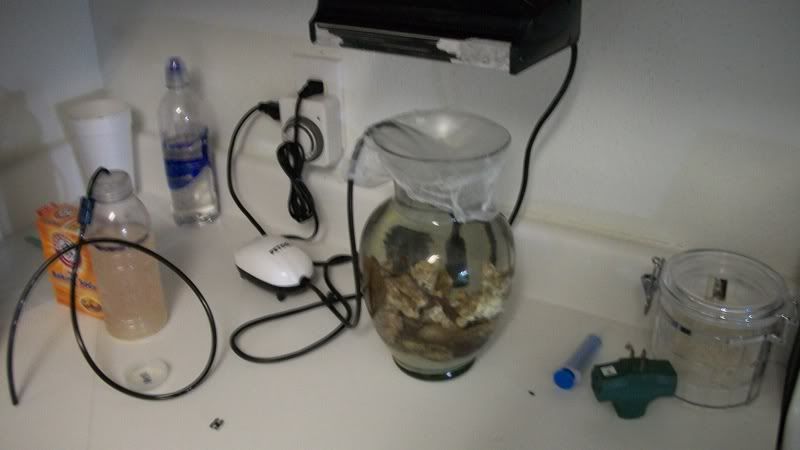
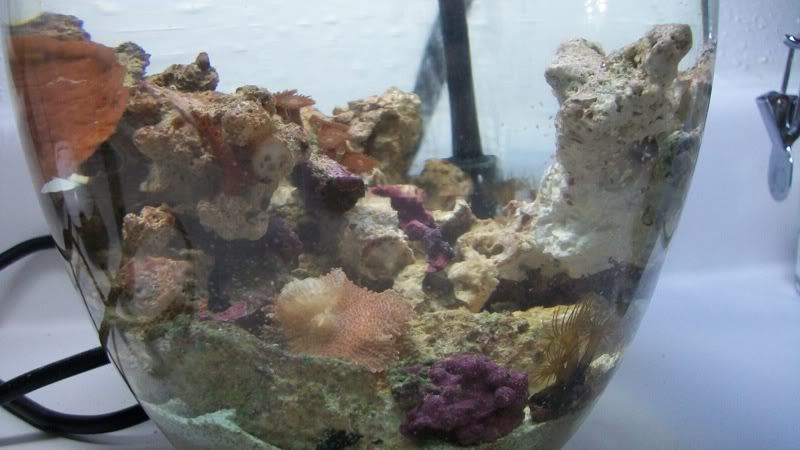
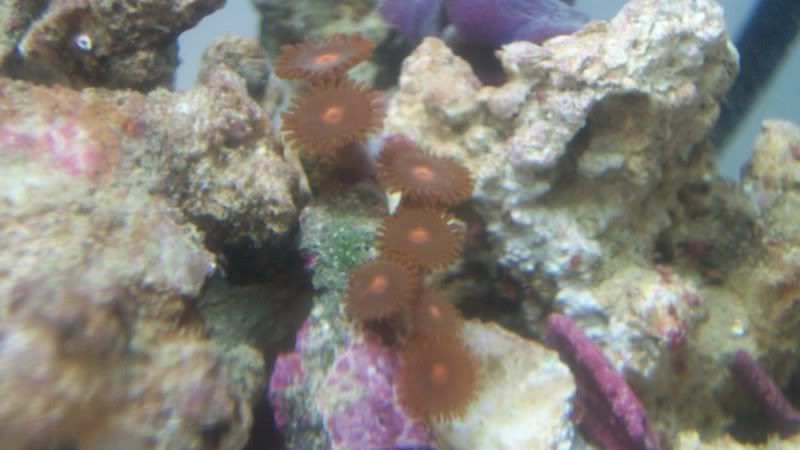
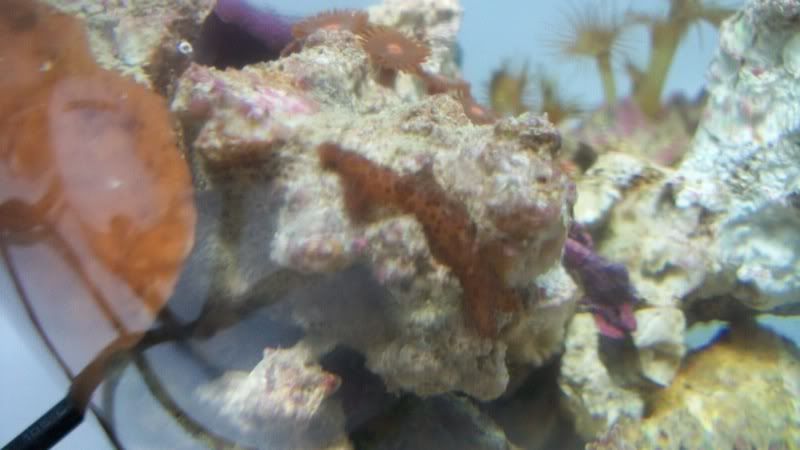
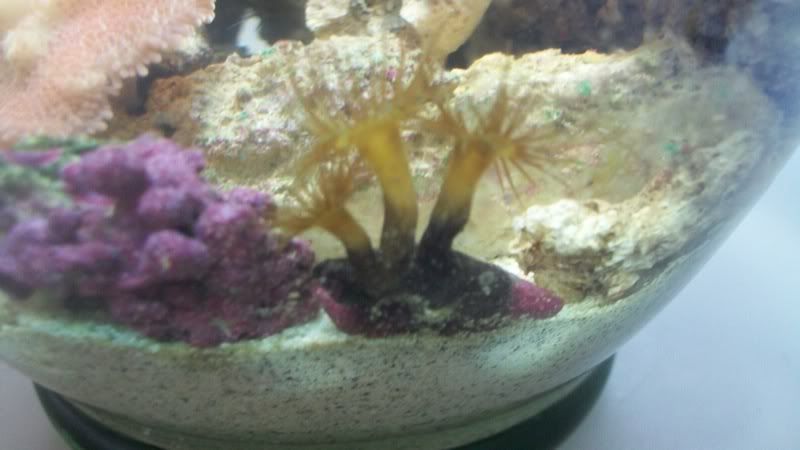

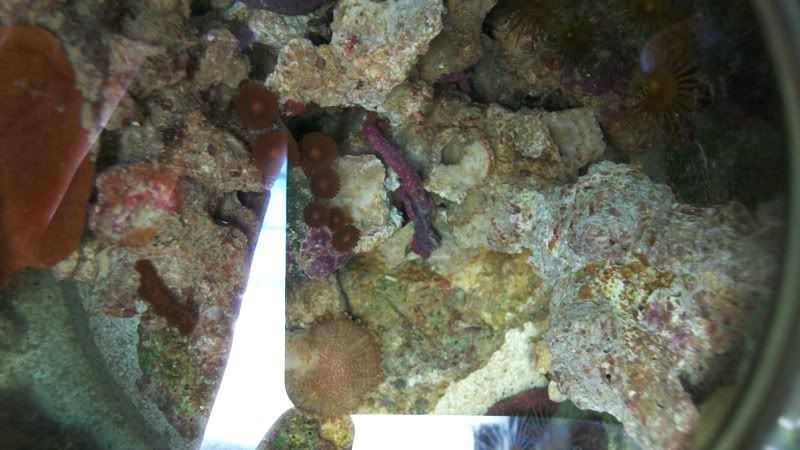
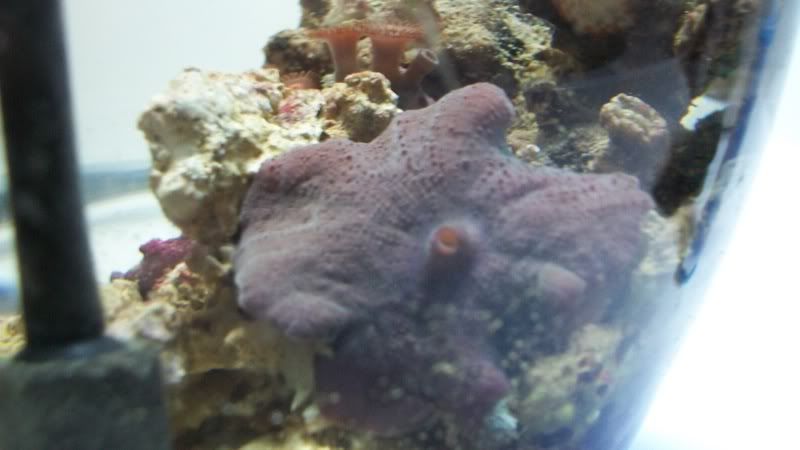
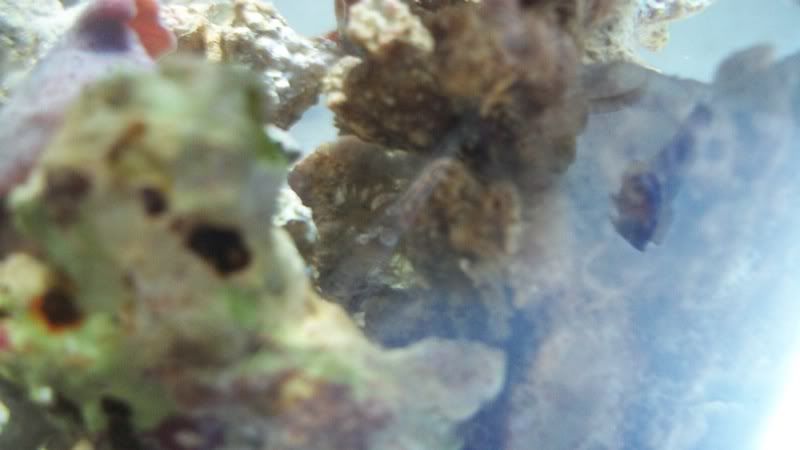
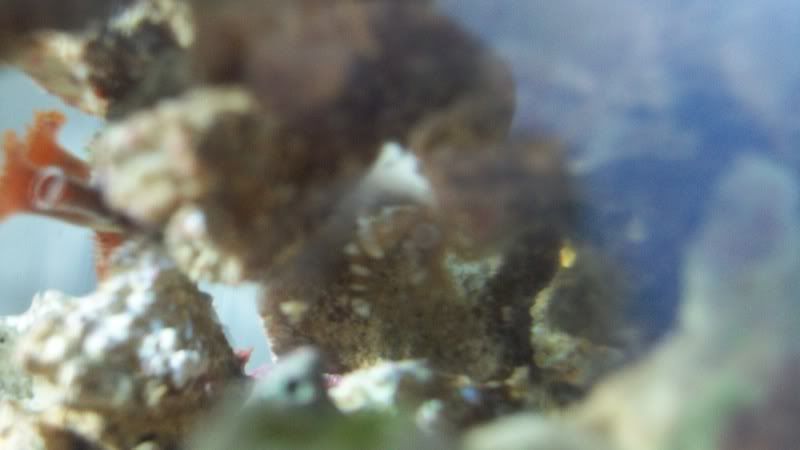
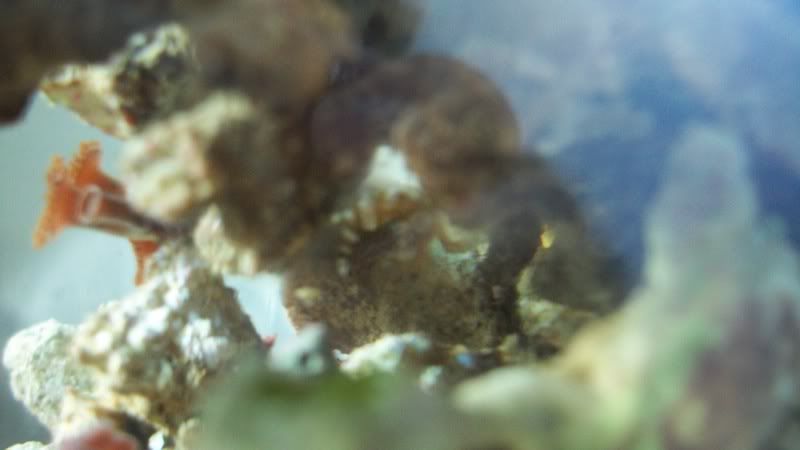
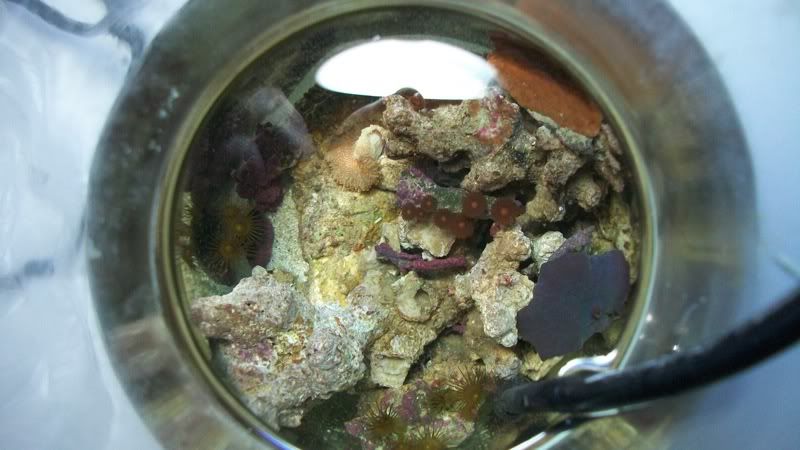
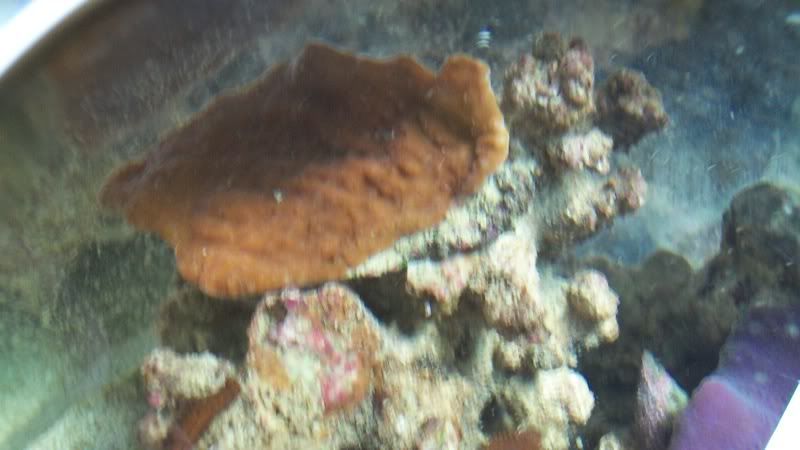
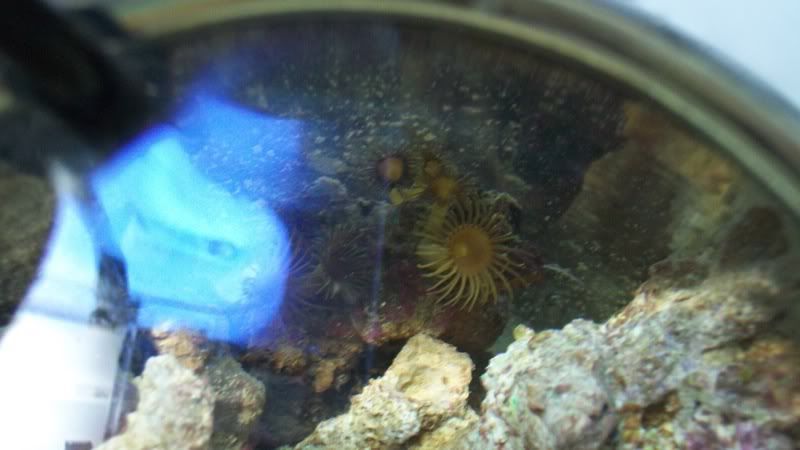
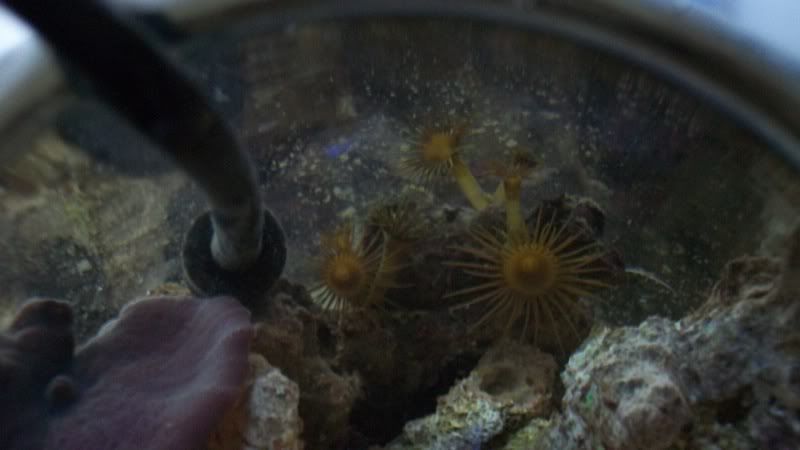
Hi mini its me your thread is really growing!
Ive been watching your thread unfold and I think you are doing great, thought Id pop in to answer some of the questions that arose during your build! Im glad you are repeating the experiment, I will now link to your thread when elbowing people in forums who say these reefbowls are fake, plumbed, unstable etcthe more the merrier where vases are concerned...
regarding drilling...no, I just laid the incoming lines from the airline and heater over the neck of the bowl. Mark K is a friend I met online and like you, he saw the vids and figured out how to drill the bowl, a blend of the reefbowl technique and the sealing-lid technique from the half gallon sealed tank. I thought this thin glass wouldn't hold a drill but was wrong!! his pics in the article show how he uses putty to create a water well, and drills with only a dremel common tool once again simplicity changed the day for the better.
Black bands--would you believe even after nearing five years on this current bowl I still get that occasionally with parazoanthus genera? You'll see zoanthids do it sometimes as well, what I have done to remedy this (anecdotally, it still happens occasionally) is to increase the feeding and also literally tweeze it off with pincer work if Im bored for an hour a couple times a year. I have not seen this zoanthid black band progress to any other corals, and lastly when the yellow polyps are fed well, they -will- reproduce, and the clones don't catch this Ive always seen it only in the parent colony. In my best guess its a reaction to acclimation of the bowl, the oxygen gradients can be really pronounced depending on a few variables within the bowl id like to casually mention.
I'll give it a shot.
noticed the water line is lower than the neck of the bowl, into the round part. This is not a problem at all, but, if you raise it to within two inches of the top of the vase, your evaporation will slow a little more and your flow will increase. more distance from the bottom of the airstone to the top of the water line=more flow. I was looking for a reference mark for your water line...are you testing the specific gravity daily or just have it memorized by now? You may indeed have one, but if not, a black marker line set at water change time gives you the level you must add fresh water to so you don't have to perform tedious sg assessments. I only let it drop a quarter inch before topping back up to that line.
Makes sense. The last pics posted show were the waterline is give or take a few cm.
I also realize until you secure a lid for your vase you are covering it, and the lower water line helps to prevent it from leaking. No prob, your corals will wait until you get it all done. Remember though, in one trip to wal mart with 88 cents in your pocket you can have a lid. its the inverted little plastic dishes from the plant/garden area that people use to sit potted plants in. Just get one, use scissors to trim it into place to fit on the -inside- diameter of the bowl, then you can raise your water line high up, which will limit the exposed surface area of the globe reef by placing the water line into the restricted neck zone, and maybe get an extra day away from the topoff needs of a lower-water line system.
Dosing: you have added a monti cap I see, either frequent water changes or good dosing will help that grow. If you are doing weekly changes it should be okay. if it starts to recess, get little pits in the center or lose color, Id make your rock wall taller inside the bowl and move that frag to the very top. Almost any light, even if really weak, can run that frag if its at the zenith of your aquascape but get ready for some browning of the coral in time, its just a problem we have to work out in pico reefs. 4 years ago everyone would be telling you not to keep that inside the vase because it would die, but the truth is with a little work you can triple it in size, and permanently affix it to the side of your vase. You can even superglue it directly to the inside of the vase along the neck somewhere and let it catch on there, its something I do with SPS all the time. The single most important thing is whatever you experiment with dosing for this tank, only add it in the mornings before lights on and never after.
No bleaching or spots so far. Actually no new ones. The coral wasn't in the best of shape when I got it, so at least the best I can tell it isn't getting worse.
A lot of people not actually keeping a vase will tell you to never dose it. I tried that route, and its my prediction no one will keep up the water changes necessary to offset the severe pH swings an aged reefbowl will always display. After months or years of running, your sandbed will have life and waste and feed particles in it and this will always generate bioacids upon respiration/catabolism, its a rule of digestion biology, and it really affects small bodies of marine water, but moreso in old age. I would never keep a vase without dosing a pH support mechanism for it. Mark K interestingly does not dose his vase; he doses the change water and lets it all mix nicely, just standing there ready for his water change day! A smart way to alter the dosing schedule...I think non dosing is possible if you never miss a water change, I just wouldn't attempt it after Ive seen what C balance will do for the system.
Morning-Only dosing:
In the mornings, your nightly respiration cycles produced carbon dioxide which did not get uptaken into the photosynthesis machine because the lights have just been off 8+ hours. This makes the reefbowl low pH in the mornings, especially when they are more than a year old, and morning dosing offsets this trend and it also delivers the calcium and alk into the small water space at a time when it's least likely to overspike the pH. If you add even a lesser dose at 3 pm, the height of photosynthesis/lowest CO2 period, you can jack your pH to 9 and kill everything in the tank. Many people choose not to dose and just religiously change water twice a week, say wednesdays and sundays and this is better than random experimentation Im thinking.
THe actual dosing I use-
C- Balance
Sunday, change water 100%
Monday, add 1/4 capfull of Yellow bottle in morning before lights on. just dump it right in the airflow output so it'll mix in well.
Tuesday, same but with blue bottle. This is the high pH part, do not overdose.
Wed, when the bowl is packed and aged, you feed heavy then do a full water change 2 hours later. This new, Id just skip dosing and let it run this day or do a 50% water changes because they are so easy. Target feed those zoanthids a little and it may help that black band situation by offsetting stress with a full gut cavity...
Thursday-Yellow bottle, scrape off glass micro algae as needed, topoff whenever that water mark gets low etc
Friday -Blue bottle
Sat-skip day
Sunday-repeat.
Dosing is going to start this week. What do you feed with? I've been wondering what I should use.
This has been my only care regimen... There are other ways, maybe all in one bottle ways like purple up, haven't tried them. This is the only way to personally guarantee no-test dosing will work because I do it everyday when here
when out of town and it doesn't get dosed nothing bad happens, but there are so many stony corals now the tank really needs the ions.
Feeding, this is a really big deal for the longevity of your vase. Without feeding, or with only bare feeding to prevent tank fouling, most of your soft corals will only live about 4 months or so. Its my observation that most zoanthid issues arise from too-clean water, as opposed to water laden with clean food that doesn't rot, and then a full water change to reset all the params back to zero. Zoanthids that were dense when new will get long and tall, their stolons will recede leaving every polyp unconnected and standing alone, and they will thin over a years time into just one or two straggle guys left, I have seen this time and time again in my systems when I used to fear feeding and all the waste it would generate.
The solution was very simple, in about 2005 it dawned on me to stop starving pico reefs or feeding them just enough to get by, and to quadruple the feeding so that these corals eat better than they do in a 200 gallon tank. All that took was coupling the feeding with the 100% water changes, problem solved totally.
try not to feed in between water changes, most days are for watching the tank grow, watching bugs and benthic life reproduce etc, these are very low maintenance systems no daily tweaking needed. only getting fed at water change time, I just lop in a huge chunk of cyclopeeze, which everyone loves, then rip out all the water in two hours. Every polyp is full, they don't mind the water changes at all, and the rest of the week they gain nutrition from the light but then can always expect that big carbon boost on wednesdays and saturday or sundays in my systems. With this method, I raise non photosynthetics like the dendrophyllias which have reproduced nicely in the system over the last two years.
cant wait to see it with a lid and all finished! Hope this helps and thank you so much for posting your build
Brandon M of Lubbock
the lid:, I even placed a corked feeding hole into the lid which functions for feeding, tweezer and coat hanger wire work ( a really good trick you should know to move around stuff ) and you can stick a hose down that feeding hole to drain out all your water! In the pic below, Im draining the tank down in the morning while coffee is making, it just sits right in front of my kitchen sink a water change takes exactly 3 mins.


